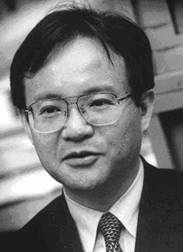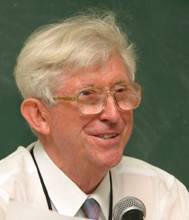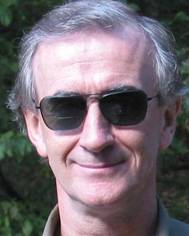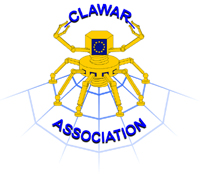
CLAWAR2007
10th International Conference on
Climbing and Walking Robots
and the Supporting Technologies for Mobile Machines
16-18 July, 2007
Singapore
Home
Organization
Call for Papers
Plenary Speakers
Paper Submission
Program Committee
Technical Program
Exhibition (and Competition)
Registration
Travel/Tour
Venue & Hotel
Contact Us
Paper Submission Link: http://www.softconf.com/start/clawar07/
(1)
From Micro to Nano and Swarm Robots

Professor Dr.-Ing. Heinz Wörn
Leiter d. Instituts für Prozessrechentechnik, Automation und Robotik
Universität Karlsruhe (TH), Engler-Bunte-Ring 8,
76131 Karlsruhe, Germany
Tel.: +49/(0)721/608-4006
Fax : +49/(0)721/608-7141
eMail: woern@ira.uka.de
ABSTRACT
Current research in Micro, Nano and Swarm Robots and results of the European projects MINIMAN, MICRON and I-SWARM will be presented. First, the design and the control of 5 to 10 cm³ sized mobile-microrobots with five degrees of freedom will be shown.They can handle miniaturized parts as for example an optical component or a biological cell with a size in the micrometre-area with an accuracy of 100nm under a microscope or a raster-electron microscope. Second, the design and the control of a 1 cm³-sized mobile untethered microrobot will be demonstrated. Here, the robot consists of five parts: the Piezzo locomotion module, the micro control unit, the communication unit, the navigation system and the micro gripper. The mobile robot can be guided and positioned in an arena with and accuracy of 5 micrometre and can be programmed and controlled over the wireless communication unit. Third, the design and the control of 9 mm³ sized micro-/nanorobots with 3 degrees of freedom will be presented. Robots vary widely in size, design, and purpose. There are robots smaller than an O2 telephone, while there are also robots that tower above any human. Their capablities grow with each year of international research and development. They can contribute to many different professional fields, from medicine to education The transmission of energy and the communication between the robots is realized via infrared. The robot controller is fully integrated and has limited functionalities. Via basic sensors communication functions and elementary rules and behaviours the microrobot can act in a swarm consisting of hundreds and thousands of robots. Future applications could be monitoring-, inspection-, exploring-tasks etc. of big areas or objects. Principal methods for swarm control , self-organiziation and collective behaviour of such an "insect-like swarm" will be shown.
ABOUT SPEAKER
Prof. Woern was born in 1948 and studied electronic engineering at the University of Stuttgart. He did his Phd thesis on “multi processor control systems”. He is an expert on robotics and automation with 18 years of industrial experience.
In 1997 he became Professor at the University of Karlsruhe for “Complex Systems in Automation and Robotics” and also head of the Institute for Process Control and Robotics at the University of Karlsruhe. Prof. Woern lead a group of about 35 scientists research in the field of robotics and the work focused on the areas of industrial robots, humanoid robots, medicine robots, micro and swarm robots.
(2)
Bipedal Humanoid Robotics and Its Applications

Professor Atsuo Takanishi
Department of Mechanical Engineering
Waseda University
3-4-1 Ookubo, Shinjuku-ku,
Tokyo 169-8555, JAPAN
Tel:+81-3-5286-3257
FAX:+81-3-5273-2209
Email:takanisi@waseda.jp
Web:www.takanishi.mech.waseda.ac.jp
ABSTRACT
Even though the market size is still small at this moment, applied fields of robots are gradually spreading from the manufacturing industry to the others in recent years. One can now easily expect that applications of robots will expand into the first and the third industrial fields as one of the important components to support our society in the 21st century. There also raises strong anticipations in Japan that robots for the personal use will coexist with humans and provide supports such as the assistance for the housework, care of the aged and the physically handicapped, since Japan is one the fastest aging societies in the world. Consequently, humanoid robots and/or animaloid robots have been treated as subjects of robotics researches in Japan such as a research tool for human/animal science, an entertainment/mental-commit robot or an assistant/agent for humans in the human living environment. Over the last couple of years, some manufactures including famous global companies started to develop prototypes or even to sell mass production robots for the purposes mentioned above, such as SONY, TMSUK, ZMP, TOYOTA, HONDA, etc. Most of those robots have two legs for its mobility . On the other hand, Waseda University, where we belong to, has been one of the leading research sites on bipedal walking robot and humanoid robot research since the late Prof. Ichiro Kato and his colleagues started the WABOT (WAseda roBOT) Projects and developed the historical humanoid robots that are WABOT-1 and WABOT-2 done in the early 70s and 80s respectively. One of the most important aspects of our research philosophy is as follows: By constructing anthropomorphic/humanoid robots that function and behave like a human, we are attempting to develop a design method of a humanoid robot having human two legs to coexist with humans naturally and symbiotically, as well as to scientifically build not only the physical model of a human but also the mental model of it from the engineering view point. Based upon the philosophy, I and my colleagues have been doing researches on bipedal humanoid robots. In my plenary speech I will introduce the research philosophy of bipedal humanoid robotics, the design and the control of the robots and its applications collaborating with robotics companies .
ABOUT SPEAKER
ATSUO TAKANISHI is a Professor of the Department of Mechanical Engineering, Waseda University and a concurrent Professor and one of the core members of the HRI (Humanoid Robotics Institute), Waseda University. He received the B.S.E degree in 1980, the M.S.E degree in 1982 and the Ph.D. degree in 1988, all in Mechanical Engineering from Waseda University.
His current researches are related to Humanoid Robots and Cyborgs, such as the biped walking robots for modeling human biped walking as bipedal humanoid robots WABIAN(WAseda BIpedal humANoid) series, the biped locomotors for carrying handicapped or elderlies as WL(Waseda Leg) series, the mastication robots WJ(Waseda Jaw) series to machanically simulate human mastication for clarifying the hypothesis in dentistry, the jaw opening - closing trainer robots WY(Waseda Yamanashi) series for patients having difficulties in jaw opening and/or closing, the flute playing robots WF(Wasada Flutist) series to quantitatively analyse human flute playing by collaborating with a professional flutist, the upper body humanoid robots WE(Waseda Eye) series whith emotionally behave like a human based upon the "Equations of Mind" including emotion, the anthropomorphic taking robots WT(Waseda Talker) series whitch mechanically speak Japanese vowel and consonant sounds, and the other themes related to his research area. Refer to www.takanishi.mech.waseda.ac.jp for more details.
He is a member of Robotics Society of Japan (a board member in 1992 and 1993), Japanese Society of Biomechanisms, Japanese Society of Mechanical Engineers, Japanese Society of Instrument and Control Engineers and Society of Mastication Systems (a major board member from 1996 to current), IEEE and other medicine and dentistry related societies in Japan.
He received Best Paper Award (Application) IEEE/RSJ IROS2003, JSME Distinguished Research Activity Award in Robotics and Mechatronics in 2003, the Best of Asia Award from Business Week Magazine in 2001, the Finalist of Best Paper Award in ICRA1999 from IEEE and RSJ in 1999, the ROBOMECH Award from RSJ and Japanese Society of Mechanical Engineers in 1998 and the Best paper Award from Robotics Society Japan(RSJ) in 1998.
(3)
Robots Walking Down Under

Professor John Billingsley
MA(Cantab), Ph D(Cantab), C Eng, C P Eng, FIEE, FIEAust.
Professor of Engineering
University of Southern Queensland
Toowoomba , Queensland 4350, Australia
Email: johnbill@usq.edu.au
http://www.usq.edu.au/users/billings/
ABSTRACT
A move to inland Australia meant leaving the industrial stimulus of Portsmouth, where walking robots could be sold to the nuclear industry, and concentrating more on agricultural applications. Nevertheless a ceiling runner was successfully developed here (and shown on UK TV) and research is making strides on several other walking projects.
One impetus for precise vision guidance of tractors is the concept of ‘controlled traffic’, minimising the compressive ‘footprint’ of the vehicle on the growing zone. Could legged agricultural implements improve on best performance? Australian methods differ in ways that could make them more attractive than in Europe.
ABOUT SPEAKER
JOHN BILLINGSLEY graduated in mathematics and in electrical engineering from Cambridge University in 1960. After four years working in the aircraft industry on autopilot design, he returned to Cambridge and gained a PhD in control theory in 1968. He led research teams in Cambridge University developing early 'mechatronic' systems including a laser phototypesetting system which was the precursor of the laser printer and the 'acoustic telescope' which enabled sound source distributions to be visualised (this was used in the development of jet engines with reduced noise). He moved to Portsmouth Polytechnic in 1976, where he founded the Robotics Research Group. The results of the Walking Robot unit led to the foundation of Portech Ltd, which for many years supplied systems to the nuclear industry for inspection and repair of containment vessels. Other units in the Robotics group have substantial funding for research in quality control and in the integration of manufacturing systems with the aid of transputers.
In April 1992 he took up a Chair of Engineering at the University of Southern Queensland in Toowoomba. His primary concern is mechatronics research and he is Director of Technology Research of the National Centre for Engineering in Agriculture. Three prototypes of new wall-climbing robots have been completed at USQ, while research on a fourth includes development of a novel proportional pneumatic valve. A substantial project in the NCEA received Cotton Research funding and concerned the guidance of a tractor by machine vision for very accurate following of rows of crop. Prototypes of the system went on trial on farms in Queensland, New South Wales and the USA for several years. In production form, it was marketed (without great success) by a major US tractor manufacturer, CASE IH. Parts of the system, however, became the successful basis for interfaces between GPS guidance systems and the automatic steering of the tractor. Other computer-vision projects have included an automatic system for the grading of broccoli heads, systems for discriminating between animal species, systems for precision counting of macadamia nuts for varietal trials..
He has taken a close interest in the presentation of engineering challenges to young engineers over many years. He has promoted the Micromouse robot maze contest around the world since 1980. Now with Mark Phythian he has simplified the Micromouse contest to become the Bilby contest, appealing to eleventh and twelfth year school contestants. He has contrived machines which have been exhibited in the 'Palais de la Decouverte' in Paris and in the 'Exploratorium' at San Fransisco, hands-on experiments to stimulate an interest in control. Several robots resulting from projects with which he was associated are now on show in the Powerhouse Museum, Sydney. He was awarded the Erskine Fellowship, University of Canterbury, New Zealand, where he spent two months February and March 2003.
(4)
Climbing Robots for Nondestructive Testing: historical perspective and future trends

Professor Bryan Bridge
Co-Director, Research Centre for Automated and Robotic NDT
Faculty of Engineering, Science and the Built Environment
London South Bank University, TWI, CLAWAR Ltd, UK
Tel: +44 (0)20 7815 7501
Mobile: +44 7913 391093
Email: bridgeb@lsbu.ac.uk
ABSTRACT
It is perhaps not well known that mobile robots were already deployed in Nondestructive Testing (NDT) in the early 1970’s, well before fixed robots came into use on manufacturing plant. The need for NDT robots first arose with the growth in exploitation of the world’s oil and gas supplies. Vast length of pipeline are involved in transporting these supplies from source to multiple destinations. Sediment and chemicals in the unrefined products cause rapid cause inner wall thinning from both erosion and chemical attack. Pipe rupture at just one point, anywhere along a pipe can cause a major environmental disaster so there was always a need to inspect complete lengths of long runs of pipe. The handling of inspection sensors by human operators would thus always involve vast and costly numbers of personnel. This situation begged for sensor handling by mobile robot. A second reason for robotic deployment arose from the fact that many pipelines were buried underground, under concrete or ran along the sea bed before rising to the surface (risers). Human placement of sensors is impossible in these cases.
ABOUT SPEAKER
Professor Bryan Bridge was born in 1941 and graduated in physics at the University of Leeds, where he also was a research student in low temperature physics. From 1965 until 1989 he was successively assistant lecturer, lecturer and Senior Lecturer in Physics at Brunel University. In 1989 he became Professor of Electrical and Electronic Engineering and Head of the Department of the same name at the now London South Bank University. Subsequently he became in turn, Head of the School of Electrical, Electronic and Information Engineering, The School of Engineering and Deputy Dean of the Faculty of Engineering, Science and Technology until 2003. Since then he devoted all his working time to personal research and research management. Whilst at Brunel, with the late Dr Jack Blitz, he was co-pioneer of the world’s first MSc Course in Non Destructive Testing of Materials This course attracted students from all round the world, funded by the British Council, the International Atomic Energy Authority, National Atomic energy authorities, and many governmental Defence Agencies. In parallel with managing this course, he became active as an NDT consultant with numerous clients over many years. His early research involved many aspects of the properties of advanced materials including ultrasonic characterization at extremes at high and low temperature. This involved the development of complex instrumentation as well as theoretical modeling. As an example he pioneered a technique for three dimensional imaging of thick, opaque, underwater off shore oil structures with single sided access only. This was based on Cobalt 60 Compton Scatter Imaging. For this work in 1990 he was awarded a Higher Doctorate (DSc) for a collection of 126 papers entitled ‘Non Destructive Characterisation of Materials. In 1992, at South Bank he founded the Research Centre for Automated and Robotic Nondestructive Testing (RCART) of which he is still Co-Director. with Dr T. P. Sattar. He has published over 300 papers, the majority in refereed physics and engineering journals and been awarded 63 personal research grants of cumulative value exceeding £9Million.He is a Fellow of 4 professional bodies: The institute of Physics, The British Institute of NDT of which he is a Technical Committee Member and former Council Member, The Institution of Electrical Engineers and the Royal Society of Art, Design and Manufactures. He is an Editorial Board Member two journal: Insight, the journal of the British Institute of NDT and Non Destructive Testing and Evaluation (Taylor and Francis).Presently he is Co-Director of RCART, Research Director of CLAWAR Ltd, European Projects Director at KCC Computer Consultancy ( London) and Consultant in the NDT Technology Group at TWI Ltd ( Cambridge).
(5)
Biomechanics and Robotics

Neville Hogan
Professor of Mechanical Engineering, and
Professor of Brain & Cognitive Sciences
Full Contact details:
Mechanical Engineering
Massachusetts Institute of Technology
77 Massachusetts Avenue
Cambridge, MA 02139-4307, USA
Tel: +1 617 253 2277
Email: neville@mit.edu
ABSTRACT
Robots are well on their way to becoming commonplace domestic appliances but to realize their true potential requires the perfection of contact robotics, machines that physically cooperate with humans. One pioneering application requiring close physical cooperation between robots and humans is the delivery of physiotherapy to facilitate recovery after orthopedic and especially neurological injury. However, controlling robots to interact effectively with humans presents unique challenges. A quantitative knowledge of human motor and sensory performance is important to optimize machines for human contact. I will briefly review our success with robotic treatment of upper-limb motor disorders and how it has profited from the availability of relatively detailed quantitative knowledge of unimpaired biomechanics and neural control of arm movement.
Robotic treatment of lower-limb motor disorders presents unique challenges as the control of locomotion is substantially more difficult and less well understood. On the engineering side, locomotion presents far greater challenges than arm movement. The dynamic process is fundamentally nonlinear, including prominent discontinuities. It is a hybrid dynamic system, switching between regimes governed by different dynamic equations. Add to these the paramount challenge of safely managing physical contact and interaction with frail human subjects. On the biological side, the relative importance of centrally-specified limb trajectories and semi-autonomous peripheral neural oscillators such as the putative locomotor pattern generator remains unclear. Furthermore, while dynamics is largely subordinated to kinematic goals in upper-limb motor behavior, musculo-skeletal mechanics appears to play a central role in controlling the lower limbs.
However, the relative importance of musculo-skeletal mechanics suggests that minimal actuation may provide substantial control authority; motors at every joint are almost certainly unnecessary. While this has obvious advantages for minimally-encumbering machine design, it makes the control problem even more difficult as the system is underactuated. I will discuss our initial investigations of the feasibility of controlling locomotion and assisting its recovery using distal actuation, in particular a two degree-of-freedom robot interacting with the ankle.
ABOUT SPEAKER
Neville Hogan is Professor of Mechanical Engineering and Professor of Brain and Cognitive Sciences at the Massachusetts Institute of Technology. He is Director of the Newman Laboratory for Biomechanics and Human Rehabilitation and a founder and director of Interactive Motion Technologies, Inc., a company offering innovative robotic tools to study and treat neuro-motor impairments. Born in Dublin, Ireland, he obtained a Dip. Eng. (with distinction) from Dublin Institute of Technology and M.S., M.E. and Ph.D. degrees from the Massachusetts Institute of Technology. Following industrial experience in engineering design, he joined MIT¡¯s school of Engineering faculty in 1979 and has served as Head and Associate Head of the MIT Mechanical Engineering Department¡¯s System Dynamics and Control Division. He has been awarded Honorary Doctorates from the Delft University of Technology and the Dublin Institute of Technology and the Silver Medal of the Royal Academy of Medicine in Ireland.
(NOTE: Due to the health, it is not wise for Professor Hogan to travel over long distance.
As a result, this talk will be substituted by the following one)
A Road from Walking Machines to Surgical Robots:
Digital Mechatronics
Professor Dr. Steven Dubowsky
Field and Space Robotics Laboratory, Room 3-469
Massachusetts Institute of Technology
Cambridge, MA 02139
Email: dubowsky@mit.edu
Abstract:
Digital mechatronic devices approximate the motion of continuous mechanisms by using a larger numbers of binary Degrees-of-Freedom. Digital mechatronic devices have excellent repeatability, are reliable, robust and are simple to control. Artificial muscle actuators that are made of elastomers are ideally suited digital mechatronic devices. These actuators have unique properties such as very large strain and large forces. They are light and inexpensive.
In the work presented here digital mechatronic systems were first considered for planetary exploration walking robots. This study has lead to the development of surgical robots that can function effectively inside of MRI systems with important medical benefits.
***************
Dr. Dubowsky is a Professor Departments in the Department of Mechanical Engineering and the Department of Aeronautics and Astronautics at the Massachusetts Institute of Technology, Cambridge, Massachusetts. He is the director of MIT Field and Space Robotics Laboratory (http://robots.mit.edu/).. He is the Principal Investigator of a number of research programs sponsored by organizations that include DARAP, NASA, The US Navy, The Center For the Integration of Medicine and Innovative Technology, industry, the Japanese Space Agency and the British government. The research of these programs focus on the design and control of robotic systems. Dr. Dubowsky has published over 300 technical and he is a Fellow of the ASME and of the IEEE.
Sponsors
Singapore Tourism Board
CLAWAR Association

Nanyang Technological University
DSO National Laboratories
International Journal of Humanoid Robotics

International Journal of Industrial Robot
Copyright: 10th International Conference on Climbing and Walking Robots



